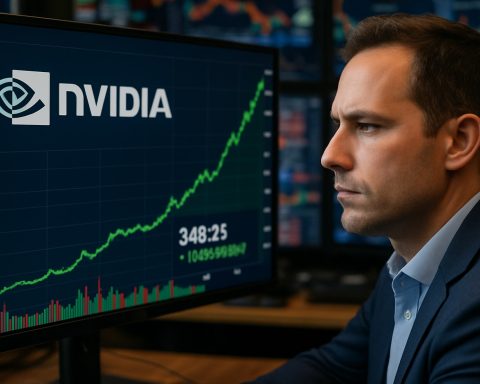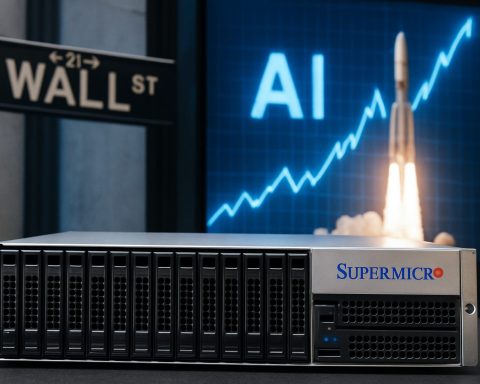- Nvidia and Palantir are pivotal players in the AI revolution, each with unique strengths and challenges.
- Nvidia excels in GPU technology, critical for AI, and faces mixed signals from the market regarding data center investments.
- Palantir’s data analytics prowess, rooted in government and expanding in commercial sectors, is transformative but subject to budgetary pressures.
- Investment perceptions diverge: Nvidia is seen as undervalued with growth potential, while Palantir is considered expensive with high growth expectations.
- Success hinges on adaptability to technological and economic shifts, with both firms needing to balance ambition with risk management.
In the hustle and bustle of the digital world, two giants stand at the crossroads of the AI revolution: Nvidia and Palantir. Their rise has been meteoric, their contributions pivotal, yet they now navigate turbulent waters. These high-flying entities epitomize the dual nature of technological ambition—unbridled potential shadowed by significant risks.
Nvidia: The Silicon Powerhouse
With its roots deep in semiconductor innovation, Nvidia has long been the Superman of graphics processing units (GPUs), essential for the fast-paced world of AI. Its proprietary CUDA software platform, born in 2006, fortifies its market stronghold, making it indispensable for AI training and inference operations. As large-scale tech firms and scrappy AI startups expand their digital frontiers, Nvidia chips fuel their quests, orchestrating a symphony of data across the globe.
Despite Nvidia’s impressive performance, reflecting in revenue growth doubling over consecutive years, whispers of downturns in AI infrastructure spending rattle confidence. With Microsoft’s recent cautionary reduction in data center projects contrasting against Alphabet’s and Amazon’s enthusiastic expansions, the stakes are high. Nvidia’s fate is tethered to the tech world’s relentless demand for computational power.
Palantir: The Data Oracle
In the realm of analytics, Palantir commands attention with its transformative approach to data interpretation. From its initial forays into government operations—forefronting initiatives like counter-terrorism—the company’s pivot to a versatile AI operating system signifies its ambitious trajectory. Recent quarters saw U.S. commercial revenues soar by 64%, while government contracts burgeoned, albeit amidst looming budgetary restraints.
As Palantir’s platform garners commercial acolytes, its prove-to-production journey symbolizes untapped potential. Yet, the specter of U.S. Department of Defense budget cuts casts uncertainty over its dominant revenue streams. The company’s future success hinges on its ability to convincingly showcase AI as a catalyst for efficiency, potentially transforming fiscal adversity into opportunity.
Navigating Valuations
The investment landscape presents stark contrasts. Nvidia, sitting at a modest forward P/E ratio, beckons as a tantalizing opportunity for prudent investors—a testament to its perceived undervaluation. Palantir, in contrast, occupies the expensive bench, with its forward price-to-sales multiple dwarfing industry norms, a signal of confidence in its growth narrative.
Thus, deploying capital into either Nvidia or Palantir requires careful consideration of market conditions, future growth trajectories, and inherent risks. While Nvidia leverages its hardware dominance, Palantir bets on its software prowess. Yet, investors should remember that in this tech-titan tango, adaptability to ever-changing technological demands and economic climates will determine the real victors.
In a digital age brimming with potentials and pitfalls, the cardinal lesson remains: astute navigation and judicious foresight are the guiding stars in the land of AI stocks.
Can Nvidia and Palantir Sustain Their AI Leadership Amidst Market Challenges?
Nvidia: The Silicon Powerhouse
Nvidia’s recent trajectory highlights both the company’s strategic acumen and the challenges it faces within the volatile tech industry. Known primarily for its pioneering graphics processing units (GPUs), Nvidia’s influence extends into AI, autonomous vehicles, and cloud computing. A key aspect of Nvidia’s success is its CUDA software platform, a parallel computing architecture that enables developers to harness the power of GPUs for various applications, particularly in AI and machine learning.
How-To Steps: Leveraging Nvidia GPUs for AI Development
1. Select Suitable Hardware: Choose a GPU that meets your project requirements, balancing performance and cost.
2. Install CUDA Toolkit: Download and install Nvidia’s CUDA Toolkit to start developing on Nvidia hardware.
3. Utilize Libraries: Integrate libraries like cuDNN for optimized neural networks and TensorRT for AI inference acceleration.
4. Develop and Test: Write CUDA code and use deep learning frameworks like TensorFlow or PyTorch, which are compatible with Nvidia GPUs.
Market Forecasts for Nvidia
According to MarketWatch, the global GPU market is anticipated to grow with a compound annual growth rate (CAGR) of 33.6% by 2026, driven by the escalating adoption of cloud-based services and AI technologies. Nvidia’s continued investment in R&D and strategic partnerships will be crucial in maintaining its competitive edge.
Security & Sustainability
Nvidia is investing in energy-efficient technologies and sustainable practices to minimize the environmental impact of its data centers. Their initiatives include using renewable energy sources and designing chips that optimize power consumption without compromising performance.
Palantir: The Data Oracle
Palantir has carved out a niche by transforming complex data into actionable intelligence. Its strong presence in governmental and commercial sectors demonstrates its versatile AI operating systems’ growing demand.
Real-World Use Cases
– Government Operations: Palantir assists in counter-terrorism and defense logistics, enhancing decision-making processes with real-time data analysis.
– Healthcare: The company’s platform is used to manage and analyze patient data, supporting personalized treatment plans and improving healthcare delivery efficiencies.
Controversies & Limitations
Palantir faces scrutiny for its role in government surveillance, raising privacy concerns. Additionally, the reliance on government contracts means that budget cuts pose a significant risk to profitability. Moving forward, expanding commercial sector offerings might mitigate these risks.
Insights & Predictions
Palantir’s future hinges on its ability to diversify its customer base, tapping more into the private sector. Analysts predict that expanding into industries like finance, manufacturing, and healthcare will be key to sustained revenue growth.
Pros & Cons Overview
Pros:
– Strong foothold in AI with substantial governmental and commercial contracts.
– Innovative technologies that streamline complex data processes.
Cons:
– High valuation could deter potential investors.
– Susceptibility to government budget cuts affecting contract renewals.
Actionable Recommendations
1. For Nvidia: Continue to lead in AI GPU innovation by investing in R&D and building strategic partnerships, especially within growing industries like autonomous vehicles and cloud computing.
2. For Palantir: Focus on mitigating risks associated with government contract dependencies by diversifying into less volatile sectors.
Quick Tips for Investors
– Analyze market conditions and technological advancements to assess the right entry point for investing in Nvidia or Palantir.
– Consider the balance between potential growth and associated risks, particularly the financial health and diversification of each company’s revenue streams.
For more information on these giants, visit link name for Nvidia and link name for Palantir.








